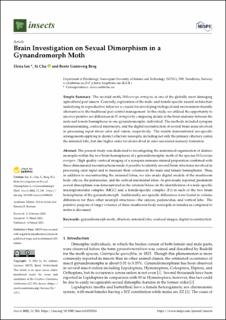| dc.description.abstract | Simple Summary
The noctuid moth, Helicoverpa armigera, is one of the globally most damaging agricultural pest insects. Generally, exploration of the male- and female-specific neural architecture underlying its reproductive behavior is crucial for developing biological and environment-friendly alternatives to the traditional pest control management. In this study, we utilized the opportunity to uncover putative sex differences in H. armigera by comparing details in the brain anatomy between the male and female hemispheres in one gynandromorphic individual. The methods included synapsin immunostaining, confocal microscopy, and the digital reconstruction of several brain areas involved in processing input about odor and vision, respectively. The results demonstrated sex-specific arrangements applying to distinct olfactory neuropils, including not only the primary olfactory center, the antennal lobe, but also higher order levels involved in odor-associated memory formation.
Abstract
The present study was dedicated to investigating the anatomical organization of distinct neuropils within the two brain hemispheres of a gynandromorphic moth of the species Helicoverpa armigera. High quality confocal imaging of a synapsin immuno-stained preparation combined with three-dimensional reconstructions made it possible to identify several brain structures involved in processing odor input and to measure their volumes in the male and female hemispheres. Thus, in addition to reconstructing the antennal lobes, we also made digital models of the mushroom body calyces, the pedunculus, and the vertical and medial lobes. As previously reported, prominent sexual dimorphism was demonstrated in the antennal lobes via the identification of a male-specific macroglomerular complex (MGC) and a female-specific complex (Fc) in each of the two brain hemispheres of the gynandromorph. Additionally, sex-specific differences were found in volume differences for three other neuropil structures—the calyces, pedunculus, and vertical lobe. The putative purpose of larger volumes of three mushroom body neuropils in females as compared to males is discussed.
Keywords:
gynandromorph moth; olfaction; antennal lobe; confocal images; digital reconstruction | en_US |

